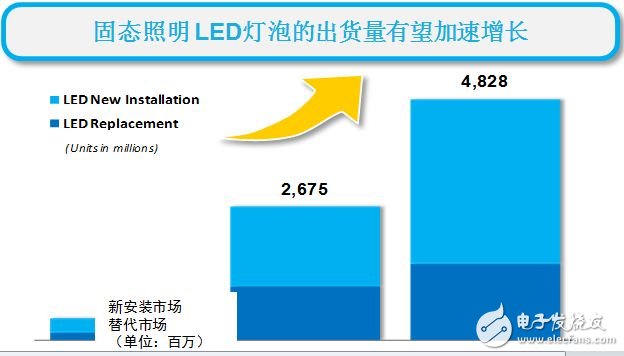2014 is a particularly important year for the LED lighting industry. Since this year, European and American countries have officially eliminated the 40~60W incandescent bulbs that are the most used in the civilian market. This provides an opportunity for the promotion and application of LED lighting in the general consumer market, and makes LED replacement bulbs a hot segment. market. According to McKinsey & Company's forecast, LED bulb shipments will increase at a compound annual growth rate of 57% from 2012 to 2016. In 2016, global solid-state lighting LED bulb shipments are expected to reach 2.6 billion units. By 2020, it will reach a scale of 4.8 billion pieces.

Solid-state lighting LED bulb shipments are expected to accelerate growth
However, while the market is rapidly developing, today's LED lighting industry is facing a common problem: how to reduce the system cost while continuously improving the use value of the product. On the one hand, in order to enter a broader civilian market, the target price of LED lamps has declined rapidly in recent years, prompting the product to move toward higher integration; on the other hand, as the LED lighting market gradually surrounds a small number of large suppliers. The integration has made the market put forward more stringent requirements for the application value of the lamps. The reliability, service life, performance in environmental protection, energy saving and intelligent control have become the primary considerations. Especially in the demand for dimming function of LED lamps, an important feature of the current market development is that dimming is no longer just to achieve the goal of energy saving, but more to reflect the gradual improvement of people's quality of life requirements. Therefore, smooth dimming performance, wireless dimming function, integration with a variety of sensors, etc., are greatly valued for the use of LED lighting in the livelihood market.
Drive intelligently and adapt to a wide range of work environments
In general lighting applications, LED lights need to be replaced with Triac dimmers in order to replace the incandescent lamps, so that on the one hand, the brightness can be adjusted according to the actual lighting requirements, thereby saving energy consumption; on the other hand, it can also be used for home or commercial applications. A variety of different lighting atmospheres and situations. For color lighting applications, such as architectural lighting and stage lighting, PWM dimming can be used to modulate various color LED luminaires. Speaking of the current challenges of dimming technology, Ven Shan, vice president of analog devices marketing at ISSI, said: “The triac dimmer has leading edge, trailing edge and digital dimmer, etc. The TRIAC dimmer is The LED driver provides a periodic chopping sinusoidal AC voltage, so the driver chip must convert this AC chopper power supply into a power supply that can be used by the LED. In addition, the 'flickering' problem that occurs during the dimming process of the lamp is also the manufacturer's design in the lamp. The problems that are often encountered."

Ven Shan, Vice President, Analog Devices Marketing, ISSI
To this end, ISSI offers a broad portfolio of HB LED driver ICs, the IS31LT3350 and IS31LT3360 are DC-DC LED driver ICs for PWM dimming or analog dimming; in addition, AC-DC driver ICs include constant current Drives the IS31LT3932 and the IS31LT3935 that supports dimming. In particular, the IS31LT3935 is a flicker-free family of devices that uses ISSI's proprietary AccuDim technology to mimic the efficiency of incandescent bulbs, allowing the dimmer to maintain a high power factor and supporting both leading and trailing edges and numbers. Dimmers save a lot of bill of materials (BOM) costs by providing fewer external components.
Speaking of the current development trend of LED lighting in dimming performance, Doug Bailey, vice president of marketing for Power IntegraTIons (PI), said: "Improving the intelligence level of the driver level will increase the application of light output. Value, this is also a good opportunity to introduce new products with enhanced control functions. Those new products with better dimming circuits and compatible with more thyristors will gain an important market position, because the market will require products to Support more customers, suitable for a wider range of working conditions or environments, to facilitate easy and fast design, and can be transplanted into different lighting design products to help lighting engineers improve work efficiency and shorten time to market."

Stefan Zudrell-Koch, Director of Strategic Marketing and Business Development, LED Products, Dialog Semiconductor Co., Ltd.
Taking PI's recently introduced LYTSwitch-4 driver IC as an example, this device for high voltage applications provides accurate output current and high efficiency for LED bulb and tube applications, high bay lighting, and excellent dimming performance. Even when used with leading and trailing edge TRIAC dimmers and with a low conduction angle, the power supply design is still NEMA SSL-7 compliant, and the drive starts faster, usually less than 500 milliseconds, even in When the light output is less than 10%, the starting speed is also fast, which eliminates the sudden brightening phenomenon.
In addition to the LED bulb replacement market, the ROHM related person also added that the current thyristor dimming has been basically popular, but limited to the replacement of the previous luminaire products, the future demand will be the use of PWM dimming technology The downlights and ceiling lamps have been confirmed in the fast-growing Japanese LED lighting market. The development of LED lighting dimming technology will be reduced to PWM dimming through MCU, which can be through wired or wireless communication technologies (such as Wi-Fi, ZigBee, Bluetooth).
It is understood that ROHM has a PWM dimming reference design for a variety of LED driver chips and is supported by its LAPIS Semiconductor subsidiary's low-power MCU and wireless technology integrated solutions to meet a variety of application needs. For example, the BM1050AF reference design for PWM dimming downlights can be applied to most downlights below 100W for complete linear dimming, and the low-power MCU can be powered from the BM1050AF's power supply pin to ensure low power The dimming performance required for power consumption and high speed processing. In addition, ROHM Shenzhen Design Center also based on the reference design of this drive and MCU, customized design for a variety of different needs, and won the praise of users.
LED Tunnel Light is a special lamp used in tunnel lighting to solve the "black hole effect" or "white hole effect" ,which caused by the sudden change of vehicle brightness when entering or leaving the tunnel.
Through the softening treatment,LED tunnel light will not make the person produce dazzling or other uncomfortable reaction.
LED Tunnel Light
Waterproof tunnel light,Waterproof LED 150W tunnel light,Portable IP66 mining tunnel light,IP66 explosion-proof mining tunnel light
Jilin Province Wanhe light Co.,Ltd , https://www.wanhelight.com